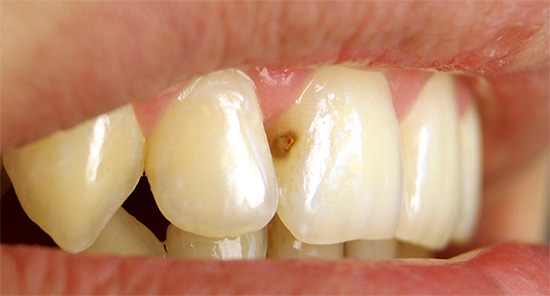
For most people, a beautiful smile is not only an indicator of good dental health and overall health, but also an important element of a career, success, and profitable dating. The appearance of caries on the front teeth can not only spoil plans for the future, but also cause serious problems in the dentofacial system with a number of possible complications (which many do not even realize until they come across).
With the enlargement and deepening of the carious cavity on the front tooth or between them, spalls of the enamel part or even the entire crown part of the tooth often occur, complications of caries with the development of severe pain (pulpitis, periodontitis), violation of the dentition (displacement relative to the natural location), impaired diction (lisping ) and serious violations of aesthetics. Often there are cases of even mental disorders with multiple caries of the front teeth, when the problem for a person becomes very painful, constant and occupying a significant part of his free time and thoughts.
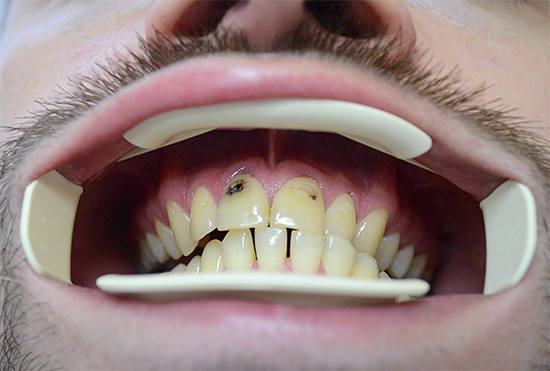
About how you can recognize in time the earliest signs of tooth decay on the front teeth, what restoration options are there today, which ones should be preferred, and how much this can cost for money - all these and some other interesting questions will be discussed further by you in more detail.
Characteristic signs of decay of the anterior teeth
Anterior teeth are characterized by a finer organization of tooth tissues: in the cervical region (gingival), the enamel is negligible in thickness, therefore it is easiest to destroy the bacteria causing caries with the formation of cervical caries. Often, cervical caries spreads here to the area of the lateral walls of the tooth and even to the inner surface with the formation of the so-called circular caries - This is a severe carious form, in which chipping and breaking off of almost the entire visible part of the affected tooth are possible.
The photo below shows examples of circular decay on anterior primary teeth child:
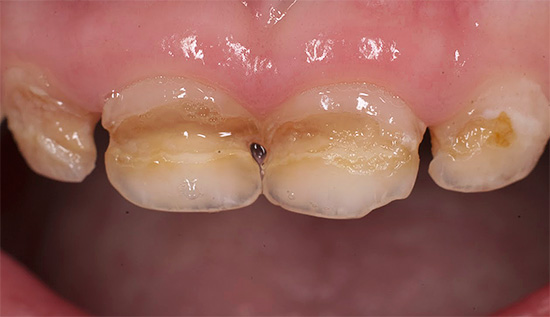
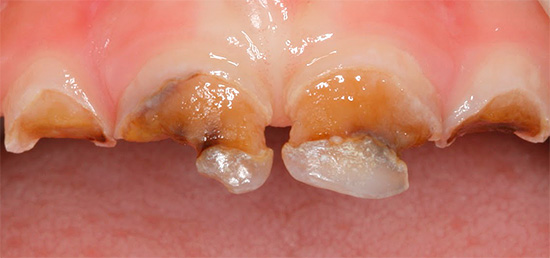
Since the front incisors are necessary for a person to bite while writing, then when they are close to each other, food residues become clogged between the teeth, often causing approximate (contact) caries or, more simply, caries between the front teeth. In this case, the wall of the incisor damaged by caries eventually becomes dark, almost black, and sooner or later the “shell” of enamel above it disappears with the formation deep carious cavity.
Photograph of caries on the contact surfaces of the front teeth:
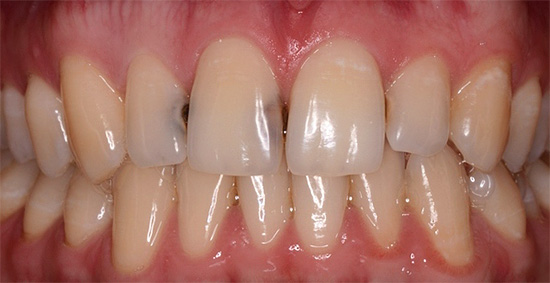
However, all these are examples of rather far-reaching carious destruction. The process can begin at first glance very harmless - just on the teeth or in the area between them there is a whitish stain. Often this is not given any significance, but in vain: the whitening of enamel already quite clearly indicates the process of its demineralization has begun, and it is at this moment that urgent steps need to be taken to save the tooth from further destruction. We will talk about this a little later.
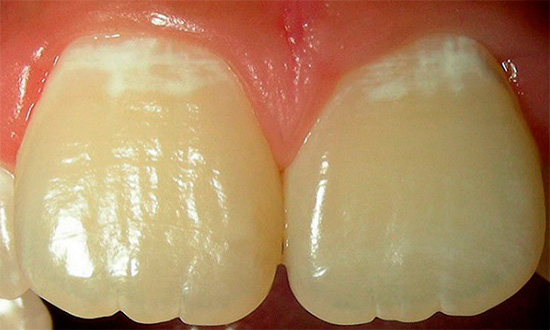
Note: “Why did the fillings on the front tooth change color so quickly?”
The fact is that the color stability of light cured composites depends on both the doctor and the patient. The most common reasons for a quick change in the color of the filling due to the doctor’s fault are: violations of the preparation technique of the cavity (carious tissues were left) and the restoration itself, the use of low-level materials, haste, insufficient knowledge of working with the material, and not informing the patient about the recommendations after the restoration.
The reasons for the color change due to the patient’s fault: failure to comply with the doctor’s recommendations (do not take dye products for 1-2 hours), failure to appear after 5-6 months for quality control of restoration and polishing of the filling, etc.
Variety of forms and possible carious manifestations
Caries on the front teeth can look very different, depending on the clinical form, type and nature of the course. So, for example, the following types of caries are distinguished depending on the depth of tissue destruction:
- initial (in the spot stage);
- superficial (caries of enamel);
- average;
- deep.
The photo below shows an example of caries in the spot stage:
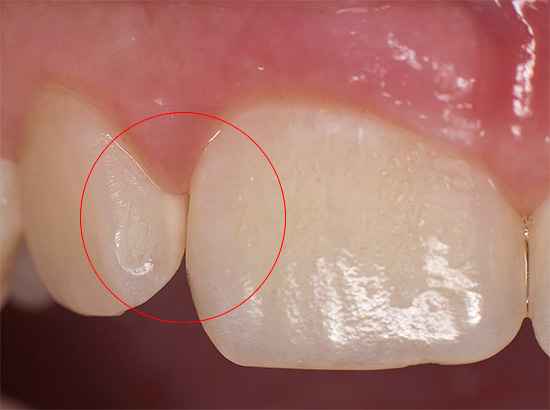
In addition, depending on the course of the disease (active or inactive), acute and chronic caries are distinguished. When a large number of carious lesions appear, several teeth are diagnosed with multiple caries at once, and cervical (circular complication) and proximal caries are distinguished by localization on the front teeth.
There is a classification of carious cavities according to Black, depending on their location. In this case, 5 classes are distinguished, the first two describing caries of the posterior teeth, and the last three characterize the carious cavities on the front teeth.
In the case of caries of the front teeth, we are talking about the following classes:
- III class. Caries affecting the lateral (contact) surfaces of incisors and canines, but without violating the integrity of the angle of the crown and cutting edge.
- IV class. Caries, in which, in addition to the lateral surfaces of incisors and canines, the cutting edge and the angle of the crown are also captured.
- V class. Caries, which occupies the cervical (subgingival) region of all groups of teeth, but to a greater extent - in the anterior on the vestibular (external) surface.
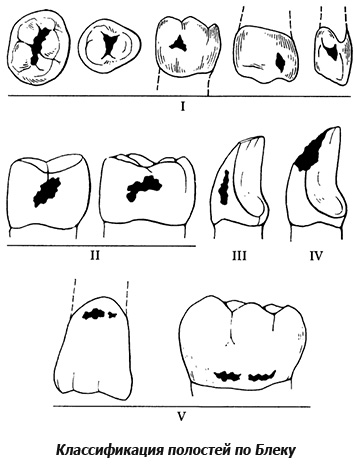
It is interesting
After the death of the author himself, the VI class was added to the working classification of carious cavities according to Black, which is used by tens of thousands of dentists, which includes carious damage to only the cutting edges of incisors and canines, as well as the tubercles of the posterior teeth. This innovation caused a storm of ambiguous emotions, and a number of dentists protested against the unauthorized decision to introduce an additional section, since Black himself could no longer influence this decision. In addition, neither the caries of the cutting edges of the front teeth, nor the carious lesion of the tubercles of the chewing teeth in practice is practically not found.
Features of restoration of the front teeth
Features of the carious process on the front teeth, in particular, its localization and degree of neglect, in many respects determine the approaches to treatment: stages of cavity treatment, equipment used and materials used. If you are already setting up on a trip to the dental clinic for treatment, then you will probably be interested to know what you can expect there ...
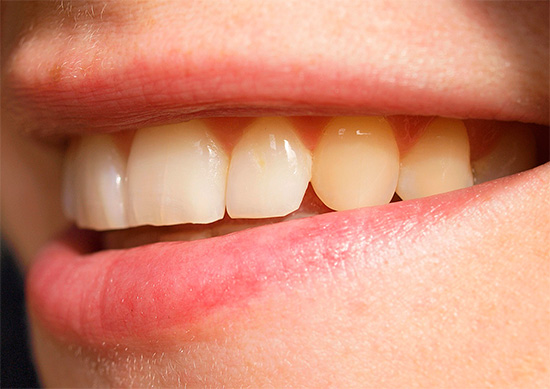
So, the most “favorable” option for your front teeth is initial caries or, otherwise, caries in the spot stage, that is, when the pathology has barely affected the enamel and has not yet gone deep into hard tissues. The first stage of the carious process, when a person can independently see the process of tooth decay, is a focal demineralization of enamel or, more simply, the appearance of a matte or pigmented (yellow, brown) spot on the surface of the front tooth. Practice shows that usually in future patients in such cases thoughts arise: is it possible to somehow whiten, polish or somehow somehow treat this spot on the front teeth of the house.
Well, caries in the spot stage can indeed be treated at home, but it is much faster, more efficient and safer to do this under the guidance of a dentist.

It is interesting
The modern approach to the treatment of caries in the spot stage without a drill is Icon technology (Aikon).This microinvasive treatment is indicated for initial caries of the anterior teeth with localization on the anterior and contact surfaces of the incisors (i.e. between the teeth). This technique is especially relevant after removal of braces, when in almost 60-80% of cases spots are detected on one or all of the front teeth. The treatment procedure usually takes no more than 20 minutes, does not require pain relief. The consistent use of the drugs included in the Icon set allows cure carious spot per visit.
Photo of the anterior tooth before and after caries treatment using Icon technology:
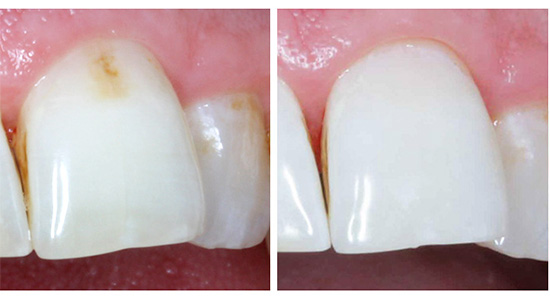
Superficial caries. For the treatment of superficial caries on the front teeth, simple grinding with discs and polishes is often used if the process has not touched the deep layers of enamel. If the desired result cannot be achieved, then the classic technology for the treatment of caries is already applied.
Medium and deep caries. If the carious process goes beyond the enamel and reaches the dentin, then we are talking about average caries. With deep caries, a cavity is formed bordering the pulp chamber. In all these cases, treatment of the cavity is required.
Photo of deep caries on the front tooth:
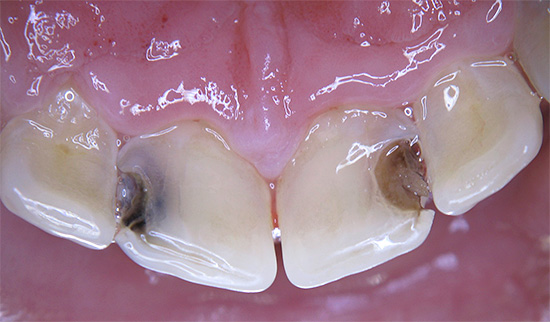
The most popular method of caries treatment in front teeth in modern dentistry is a mechanical one using burs and hand tools. Dissection (treatment of the cavity) using a drill allows the most complete excision of carious tissue to prevent relapse of caries and create an aesthetic filling.
The air-abrasive method using sandblasting the cavity allows you to gently process small carious areas on the front teeth using an aerosol with an abrasive substance.
The laser method of dentistry is still not widely used due to the fact that not all clinics can afford expensive equipment. In addition, some researchers have doubts about the effectiveness of laser treatment in certain clinical cases of caries.
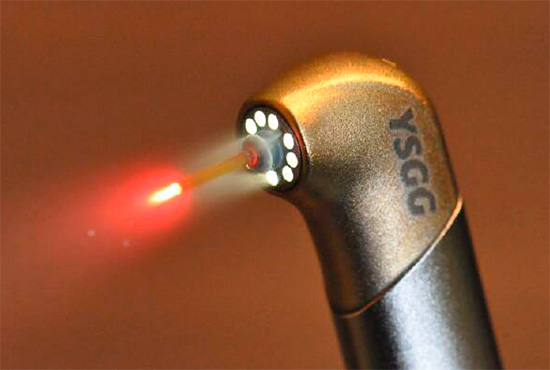
Note: “What should I do if a part of my front tooth breaks off from a blow?”
An urgent need to contact a dentist for radiography of the root of the tooth. The fact is that as a result of an impact, not only the crown part, but also the root part can be damaged, therefore it is important to identify a root fracture in time in order to implement an integrated approach to treatment. If the root is in order and the “nerve” is not affected, they make a simultaneous restoration of the front tooth, if there is damage to the soft tissues inside the tooth, they treat the canal and only then fill it.
A mechanical method for treating caries on anterior teeth with a drill provides maximum excision of not only softened carious tissues, but also pigmented ones. This is due to the fundamental position regarding future aesthetics. Indeed, if even a small area of pigmented dentin or a dark spot on the enamel is left, then next to the seal, at least the appearance of the restoration will be disrupted, and as a maximum, repeated caries under the seal will soon occur.
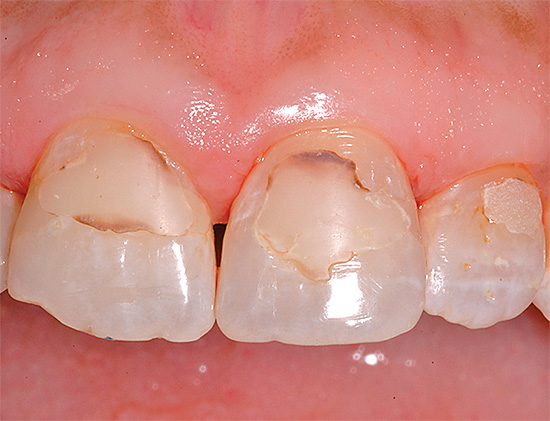
In the video below, you can follow the main steps in the treatment of deep caries on the front tooth using a drill:
Interesting video: an example of the treatment of deep caries on the front tooth
During mechanical treatment of the cavity, an important component of treatment is the jet supply of water to the tooth, since first of all on the front teeth thin layers of tissue (enamel, dentin) and the proximity of the pulp chamber determine serious risks of overheating, up to necrosis. In such cases, the tooth begins to hurt under the filling, and in the future it will be necessary to remove the dental “nerve”.
From the practice of the dentist
Often, patients come to the dentist's office complaining of severe pain in the front tooth and think that this caries “got sick”, although in fact the infection has already reached the tooth “nerve” and pulpitis has begun.Symptoms that arise in this case in a diseased tooth can sometimes be quite similar to a caries clinic: pain can be minor or none at all, external irritants do not provoke a painful reaction in the tooth or it is weak. If the doctor nevertheless finds out that it is pulpitis, then there is no way to get rid of one seal ...
First, anesthesia is mandatory, then the carious cavity is cleaned of infected tissues, amputation and extirpation of the “nerve” are performed (extraction from the root canal). The canal is washed with various antiseptics (hydrogen peroxide, sodium hypochlorite, etc.) and sealed to the top, that is, to the physiological narrowing of the root, with hardening filling material with or without gutta-percha pins. Work on the complete treatment of pulpitis can be carried out in one visit or in several, depending on the level of technical equipment of the clinic, the features of the tooth itself, the professionalism of the doctor and the approach he practices in such procedures.
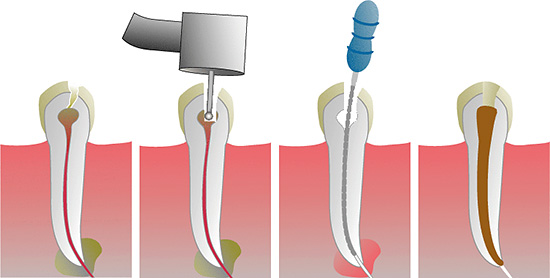
After anesthesia, clarification of the carious cavity, its drug treatment with antiseptic solutions and the formation of a cavity for the material used, the color of the future restoration is determined. The materials used for restoration of anterior teeth during caries are in most cases light cured composites. Each kit produced by a particular company has its own color characteristics (syringe sets with a specific color).
Before restoration, the dentist evaluates:
- transparency, tooth tone and color scheme;
- tooth shades by zones: in the cervical part, in the area of the tooth body and at the cutting edge;
- individual tooth features (hypoplasia spots, the presence of cracks).
Ideally, after restoration, its surface should not resemble a “patch”, as it was in Soviet times. The finished work should have a set of such individual characteristics so that after polishing the fill, a natural shine characteristic of enamel appears, each tooth zone has its own shade of color, the tooth has the same characteristic lines, microcracks, translucent congenital spots. Artistic restoration of the front tooth often takes up to 2 hours or more.
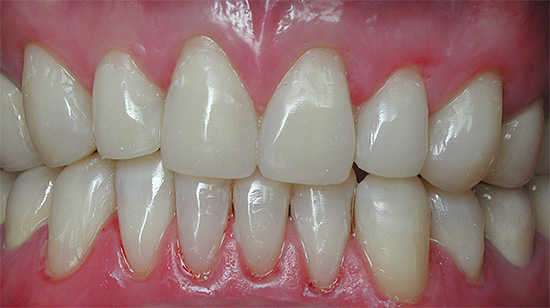
On a note
There are various approaches to assessing the final result: there is an opinion that the ideal restoration after filling should be in harmony with the front tooth symmetrical to it. In other words, if there are natural fossae, spots, lines, etc. on the symmetrical central incisor, then on the tooth being restored due to caries, they are also recreated.
Some experts are of the opinion that the final restoration of the front tooth should be matched in shape and color to the restored tooth and to the adjacent one, but no more. At the same time, the errors that nature created on a symmetrical cutter and which look naturally from the side do not repeat when restoring a seal. This is not to say that such a restoration technique is considered not popular.
It is advisable in advance (before treatment) to agree with the doctor what result you like best and build on the individual characteristics of the tooth.
The role of prevention in maintaining front teeth
Prevention of tooth decay on the front teeth is currently leading to maintaining a beautiful smile zone. The complex of such events can be divided into systemic and local applications.
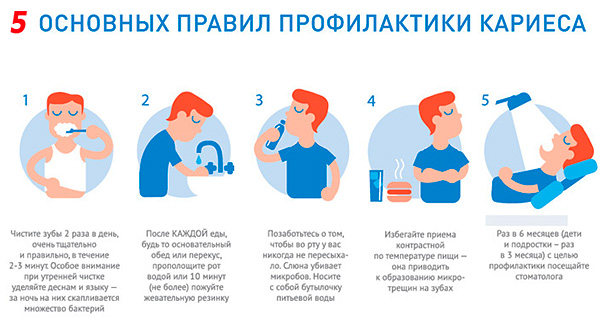
Systemic preventative measures include:
- restriction of carbohydrate intake and priority for fruits and vegetables for self-cleaning of spaces between the front teeth, where plaque and food accumulate;
- the use of foods containing calcium in large quantities (milk and dairy products);
- fluoride prophylaxis under the supervision of a dentist using fluorinated water, salt or milk, as well as taking fluoride-containing tablets.
Local preventive measures:
- cleaning the front and side teeth with fluoride and calcium pastes after each meal;
- the use of mouthwashes with fluoride (see example below in the photo);

- remineralizing therapy and deep fluoridation of the front teeth at the dental appointment and in the future - home use of special mineralizing gels or solutions.
How much can the treatment cost?
Compared to the treatment of caries in the posterior teeth, restoration of the anterior teeth is an expensive pleasure. The pricing of the clinic depends on the type of caries (initial, middle, deep), its location (cervical, approximate) and the area of destruction. This determines the complexity and duration of treatment.
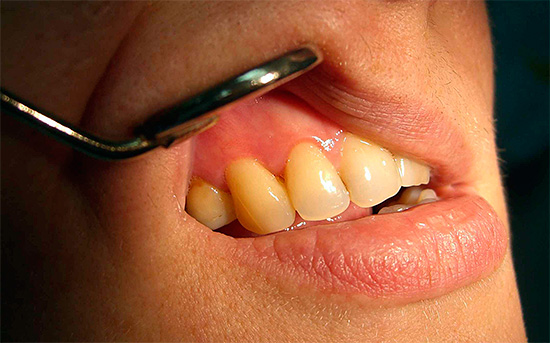
The level of technical equipment of the clinic, the materials used for the restoration of the front teeth (economy class, business class, etc.), the professionalism of the dentist, as well as the chosen approach to the treatment of caries and the technique of work are important.
For example, if the treatment of caries at the front incisor in the clinic takes no more than 20-30 minutes, the best composite of light curing is selected, then the usual “patch” from the seal, which is often striking to others, can become a natural result of such treatment. In this case, one does not have to talk about a beautiful smile.
Art restoration usually has an increased cost, but the result is an individual work that others only after close examination at point-blank range will be able to detect, and even then not always.
There is also a copyright restoration. This is the same artistic restoration, but the dentist’s personal achievements, original techniques, unique techniques used during work, a combination of materials and some other techniques are embedded in it. The price here is sometimes prohibitively high for a simple layman, but beautiful teeth can really be worth it.
Interesting video: an example of restoration of the front teeth with deep caries
How to deal with tooth decay

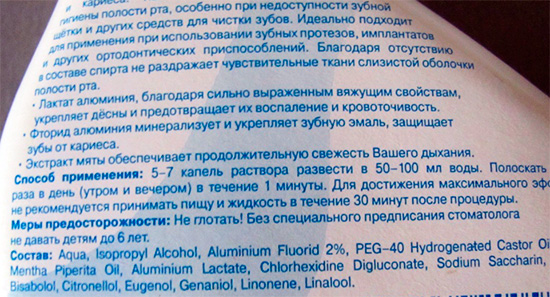
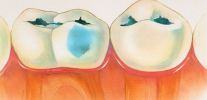
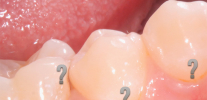
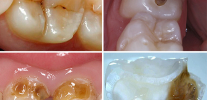
Tin. I have caries and I’m very afraid ...
Cured?
If you are afraid, then ask for an injection, after which we sit down, relax and “enjoy”. The most painful thing is an injection, but you are not afraid of injections? )))
The injection is sick, but you can tolerate. But the mouth will not open for 3 days, it will hurt and the cheek will swell. So I don’t know ...
I also have caries on my front tooth, but I'm afraid to go to the dentist. Knowing that it will be even worse.
Hello! I recommend that you consult a doctor so as not to bring to severe pain and subsequently to tooth extraction. Girls often turn to the dentist mainly from the point of view of cosmetology. When the carious front tooth violates the aesthetics, then filling it in 1-2 visits allows you to return or even improve the color and shape of the front tooth. If a tooth is not taken up now, then its condition will only worsen.
Today, almost everything is done with anesthesia (although you yourself can refuse anesthetic) - the dentist takes care of the patient’s peace so that it does not hurt. So do not be afraid.
I already have a hole, I'm depressed ((
It is not painful to treat, even an injection is not necessary!
This is pipets ... I generally need to save my front teeth, I need to work. I can’t smile. We must run to the doctor ...